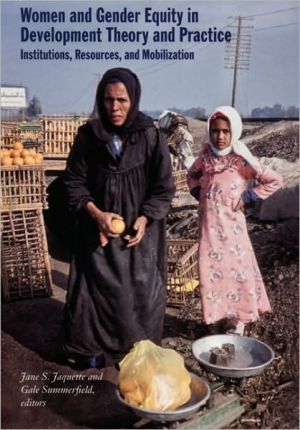Women and Gender Equity in Development Theory and Practice: Institutions, Resources, and Mobilization
Seeking to catalyze innovative thinking and practice within the field of women and gender in development, editors Jane S. Jaquette and Gale Summerfield have brought together scholars, policymakers, and development workers to reflect on where the field is today and where it is headed. The contributors draw from their experiences and research in Latin America, Asia, and Africa to illuminate the connections between women’s well-being and globalization, environmental conservation, land rights,...
Search in google:
Collection of essays on issues of women and development, attempting to bridge theory and practice in the post-9/11 era to reflect debates in various realms, from the environment, land rights, and identity to information technology, employment, and poverty
Women and Gender Equity in Development Theory and Practice\ Institutions, Resources, and Mobilization \ \ Duke University Press\ Copyright © 2006 Duke University Press\ All right reserved.\ ISBN: 978-0-8223-3700-3 \ \ \ \ Chapter One\ Institutional Opportunities and Barriers\ Women, Gender, and Development\ Jane S. Jaquette and Kathleen Staudt\ By many measures, the field of women/gender and development (WID/GAD) is quite robust. The UN Development Program (UNDP) and other UN agencies have made gender a focus of their development reviews. The World Bank (2001a), long noted for its resistance to gender issues, recently published Engendering Development Through Gender Equality in Rights, Resources and Voice, linking development to the broader context of women's rights, the explicit focus of a new volume edited by Maxine Molyneux and Shahra Razavi (2003). Economists Diane Elson (1995a, 2003), and Lourdes Benería (2003) use gender as a fulcrum to better understand and critique economic processes of globalization.\ WID and GAD analyses have had an impact on development discourse and on the way aid is administered, but they have been less successful in making a material difference for the vast majority of women in developing countries. Development is not mainly produced by the actions of donor agencies, of course. In the last decade, the direction of economic change has been vastly more affected by private capital flows, currency crises, privatization, and the pressure to adopt open markets and export-oriented growth than by public or private development assistance. Cuts in social spending have increased the burdens on women's labor. Declining incomes and higher male unemployment have pushed women into paid work. Women's labor is the key to export strategies based on free trade zones (FTZS). Market reforms have not generated the growth that the reformers promised. Inequalities are increasing, and the number of people living in poverty, a category disproportionately occupied by women and children, has been growing (see Benería 2003).\ Yet donor agencies remain an important arena for addressing development issues and pursuing gender equity. Donors, not markets, engage in policy dialogues, take social criteria into account, and try to implement "participatory development." Bureaucracies are often thought of as resistant to change. In our experience, development agencies and NGOs actively seek new approaches, and advocates for women can take advantage of these openings. Growing discontent with "market fundamentalism" may also provide opportunities that those in the field should be prepared to pursue.\ However, the field is divided, and advocates and scholars seem unable to move beyond the debates that were salient over a decade ago. In the thirty years since Ester Boserup published her classic study, Woman's Role in Economic Development (1970), two major approaches have dominated the field. The women in development (WID) model challenged the male bias in foreign assistance in the 1970s, and the gender and development (GAD) approach, which emerged in the late 1980s, put women and development in the context of gender power relations.\ This essay reviews WID and GAD with two goals in mind. The first is historical. It is clear that both models reflected trends in feminist theory: WID drew on the liberal egalitarianism of "second wave" Northern feminism in the 1970s, and GAD responded to the rise of postcolonial feminism and the impressive growth of Third World women's movements in the 1980s. But the turn from WID to GAD in the late 1980s (and the addition of the "democracy agenda" by the 1990s) were also reactions to major shifts in the international system. In the 1960s and 70s, international development politics operated from Keynesian assumptions, which were being pushed to the left by dependency theory and the North/South dialogue. By the mid-1980s, supply side economics had displaced Keynesianism, and the neoliberal Washington Consensus remains the dominant view twenty years later. Economic "liberalization" was joined by policies to promote political "liberalization"-democracy-in the 1990s, after the fall of the Berlin Wall. Putting WID and GAD in this broader international context makes it possible to move away from seeing these two models as competing "truths" about how to approach women and development to understanding them as successive efforts to respond to-and influence-changing policy environments.\ The second rationale for this essay is political. September 11 has changed the dynamics of the international system once again. It is our hope that reframing the WID/GAD debate may provoke creative thinking as the international system enters a new phase of rapid change that may push aside or distort women's agendas.\ SHIFTS IN THE INTERNATIONAL SYSTEM: 1975-1990S\ Since 1975, when women met in Mexico City for the first conference of what became the un Decade for Women, the international system has undergone three significant shifts associated with, although not entirely caused by, changes in U.S. foreign policy.\ In the 1970s, the United Nations General Assembly, following the logic of dependency theory, was calling for a New International Economic Order (NIEO) that would substantially redistribute resources from the wealthy North to the underdeveloped South. Under President Jimmy Carter (1976-80), the United States, defeated in Vietnam, tried to become a better global citizen. Carter negotiated the Panama Canal treaties, brokered the Camp David agreements, and argued that the United States should accept environmental limits to growth.\ The election of Ronald Reagan (1980-88) reversed those trends. Carrying out a "monetarist" revolution that was thirty years in the making, the Reagan administration rejected the Keynesian consensus that had guided U.S. policy since the Depression. With strong support from British Prime Minister Margaret Thatcher, Reagan promoted open markets and opposed statism at home and abroad. Helped by the debt crisis, the neoliberal reformers cut a wide swath. The International Monetary Fund (IMF) began to condition its loans on the adoption of structural adjustment programs (SAPS), which reduced the role of the state, privatized assets, and opened up many of the world's economies to expanded foreign trade and investment (e.g., Kucynski and Williamson 2003; J. Richardson 2001).\ In the early 1990s, the disintegration of the Soviet Union, the adoption of market reforms in the former Eastern bloc and their consolidation in China further buttressed the neoliberal model against those who had begun to document its human costs. Democratization created tensions between economic and political reforms. Those who lost jobs, social services, and economic opportunities as a result of government cutbacks and lowered tariff barriers expressed their discontent through the ballot box, but to little avail as presidents elected on platforms to resist IMF reforms often succumbed to international pressures once elected. The end of the Eastern bloc produced a single international finance and trade system, further reinforcing the market model.\ The 1990s were also marked by new forms of resistance, including the Zapatista revolt in Chiapas, the rise of such populist leaders as Hugo Chavez in Latin America, the resistance of indigenous movements, and protests in Seattle, Cancun, and elsewhere against the World Trade Organization and other symbols of globalization. Criticism of the way the IMF handled the Asian currency crises indicated that the Consensus might be breaking down.\ The United States had preponderant power in the 1990s but used it ambivalently. After the first Gulf war, U.S. interventions in the former Yugoslavia, Haiti, Somalia, and Kosovo were carried out under multilateral mandates but were not popular at home. The events of September 11, 2001, moved the United States from debating the costs and benefits of humanitarian interventions to preventive war. The invasion of Iraq undermined the Western alliance, weakened the United Nations, and likely increased the likelihood of terrorist attacks around the globe.\ U.S. policy alone does not determine what happens in the international system. But changes in U.S. leadership have set the tone for international politics since World War II. Recent administrations have remained wedded to an economic model that is not only globalizing but hostile to the state, and there is no alternative in sight. Whether the international opposition to U.S. unilateralism will create space for challenges to U.S. leadership-and to economic orthodoxy-is possible, but not a likely outcome. Yet September 11 and the U.S. invasion of Iraq have unsettled the international system and may offer a new context for the development debate.\ INTERNATIONAL WOMEN'S MOVEMENTS AND THE UN CONFERENCES ON WOMEN\ The foregoing brief history of international politics over the last thirty years ignores an important phenomenon: the dramatic rise of women's movements over these same three decades, which has given women greater voice and has increased their access to political power. In this period, women's movements have brought about unprecedented changes in women's roles and status. But the wave of women's empowerment may have reached its peak. It is clear that, without continued efforts to increase women's control over resources, current gains could be lost.\ After the establishment of the United Nations at the close of World War II (sex was included among the forms of discrimination banned by its charter), a few women on the un Commission on the Status of Women (CSW), led by Finnish feminist Helvi Sipila, worked within the un to raise women's issues. In 1970, the CSW succeeded in getting the General Assembly to pass a resolution encouraging "full integration of women in the total development effort" (Tinker 1990b, 29). In 1972 the General Assembly declared 1975 International Women's Year (IWY), and in 1974 it approved a conference on women, to take place in Mexico City in 1975.\ Most CSW efforts had focused on improving women's legal status. But in the 1960s and 70s, the UN General Assembly was gripped by the issue of development. Its deliberations were strongly influenced by dependency theory, the view that the South was not merely undeveloped but had been exploited by the North through decades, even centuries, of unequal trade. Declaring the 1970s the Second Development Decade, the General Assembly called for transfers of capital and technology from North to South and the stabilization of the prices of primary products, which comprised the bulk of Third World exports.\ In June 1975, just prior to the Mexico City conference, the American Association for the Advancement of Science brought together 95 women and men from 55 countries to discuss women and development. The seminar focused on the lack of reliable data on women's economic participation. It "naively assumed," as organizer Irene Tinker later wrote, "that correcting the biases of data concerning women's work and exposing the constraints on women's education and credit would automatically solve many [gender] inequalities as planners incorporated the new data and insights into their programming" (Tinker 1990a, 5).\ Efforts to put women on the development agenda in the 1970s coincided with the recognition on the part of many donors that their programs had not "trickled down" to the poor. Under the leadership of Robert McNamara (1968-81), the World Bank adopted Basic Human Needs as a priority. Although the Bank remained firmly in the hands of economists, anthropologists and other social scientists joined its and other donor staffs, providing a more sympathetic audience to those concerned about sex discrimination. Private philanthropic institutions like the Ford Foundation (Flora 1982) joined the Rockefeller Foundation (long known for its health and population programs) as significant players in the emerging "development community." Several UN agencies as well as European and Canadian bilateral donors began to give serious attention to poverty and to women's status (as it was then called) as related development issues.\ As each delegation presented an analysis of the status of women in their country, pulling together basic demographic data, statistics on women's health, income, labor force participation, education and, where available, political participation, the socialist countries made impressive showings. This reinforced those who argued-much more persuasively in the 1970s than is remembered today-that socialist revolution was a prerequisite to making real advances in equality for women.\ The Mexico "Plan of Action" called upon governments, the private sector, and un agencies to take specific actions to remedy "sex" disparities. It focused on women's legal rights and economic disadvantages, but skirted the issue of political representation, which was not surprising given that the majority of the delegations represented countries under authoritarian rule. The process of preparing for the conference had the unintended effect of raising political awareness of women's issues in many countries and provided an excuse for women to meet, sowing the seeds for a subsequent wave of women's organizing. Those from the North who attended the official meeting and the parallel NGO Tribune in Mexico City expected to focus on feminist issues. However, the official debates soon revealed deep divisions between North and South. U.S. feminists who attended the Tribune looked forward to a spirit of global sisterhood, but soon learned that most Third World women rejected "feminism" as hostile to men and believed that economic exploitation by the North, not patriarchy, was the major cause of women's oppression.\ After IWY the General Assembly declared 1975-85 the Decade for Women. Women's movements grew exponentially, organizing to address issues from human rights and the environment to day care, health, and reproductive rights. Some groups were organized by donor agencies as a means to extend credit and training more effectively, while local self-help organizations proliferated to provide safety nets for those pushed further into poverty by the economic crises of the 1980s. Over the Decade (1975-85), as assumptions about international feminist solidarity were questioned, the issue of violence against women emerged as a shared concern that could bring women together across national, class, and cultural divides.\ The Mid-Decade Conference in 1980, hastily switched to Copenhagen from Teheran after the Iranian revolution in 1979, was highly politicized. By contrast, the End of the Decade meeting in Nairobi in 1985 was relatively harmonious and, at U.S. insistence, the language of the final document was decided by consensus. Whether the spirit of cooperation in Nairobi was due to the maturity of the international women's movement or to the strong-arm tactics of the Reagan and Thatcher administrations (which had buried the "North/South dialogue")-or both-is hard to judge. What is clear is that the Decade was a spur to women's organizing and helped create transnational networks of women's groups. Women's organizations used the commitments their governments made in Mexico City, Copenhagen, and Nairobi to lobby for more egalitarian legislation at home. By the 1990s, most of the world's governments (but not the United States) had ratified the 1979 Convention on the Elimination of All Forms of Discrimination Against Women (CEDAW).\ (Continues...)\ \ \ \ \ Excerpted from Women and Gender Equity in Development Theory and Practice Copyright © 2006 by Duke University Press . Excerpted by permission.\ All rights reserved. No part of this excerpt may be reproduced or reprinted without permission in writing from the publisher.\ Excerpts are provided by Dial-A-Book Inc. solely for the personal use of visitors to this web site. \ \
Contents Preface and Acknowledgments....................vii Introduction Jane S. Jaquette and Gale Summerfield....................1 I. Institutional Opportunities and Barriers....................15 Women, Gender, and Development Jane S. Jaquette and Kathleen Staudt....................17 Mainstreaming Gender in International Organizations Elisabeth Prügl and Audrey Lustgarten....................53 From "Home Economics" to "Microfinance": Gender Rhetoric and Bureaucratic Resistance David Hirschmann....................71 Contributions of a Gender Perspective to the Analysis of Poverty Sylvia Chant....................87 What is Justice? Indigenous Women in Andean Development Projects Maruja Barrig....................107 II. Livelihood and Control of Resources....................135 Gender Equity and Rural Land Reform in China Gale Summerfield....................137 Unequal Rights: Women and Property Diana Lee-Smith and Catalina Hinchey Trujillo....................159 On Loan from Home: Women's Participation in Formulating Human Settlements Policies Faranak Miraftab....................173 In Theory and in Practice: Women Creating Better Accounts of the World Louise Fortmann....................191 Women's Work: The Kitchen Kills More than the Sword Kirk R. Smith....................202 III. Women's Mobilization and Power....................217 Women's Movements in the Globalizing World: The Case of Thailand Amara Pongsapich....................219 T-Shirts to Web Links: Women Connect! Communications Capacity-Building with Women's NGOs Doe Mayer, Barbara Pillsbury,and Muadi Mukenge....................240 Empowerment Just Happened: The Unexpected Expansion of Women's Organizations Irene Tinker....................268 Acronyms....................303 Bibliography....................306 Contributors....................352 Index....................357
\ From the Publisher“This book begins with a very important question: is there a crisis in the gender and development field despite its large expansion and growing complexity? The different contributors address this question, directly or indirectly, from an interdisciplinary perspective. From the analysis of changing institutions to the control of resources, political participation, gender mainstreaming, and many other relevant themes, the book makes an excellent contribution to the historical analysis of the field and its current developments and tensions. There is much food for thought here.”—Lourdes Benería, author of Gender, Development, and Globalization: Economics as if All People Mattered\ “This excellent collection by leading scholars and policy actors sets the ongoing gender and development debate in the context of the changing international political and policy climate. In bringing different regional perspectives to bear on the new challenges facing gender justice advocates, it updates critical thinking on the urgency of applying gender analysis to development policy, human security, and globalization.”—Maxine Molyneux, author of Women’s Movements in International Perspective: Latin America and Beyond\ “This important collection provides a much-needed fresh look at women, gender, and development. Jane S. Jaquette and Gale Summerfield’s overview chapter is superb.”—Valentine M. Moghadam, UNESCO\ \ \








